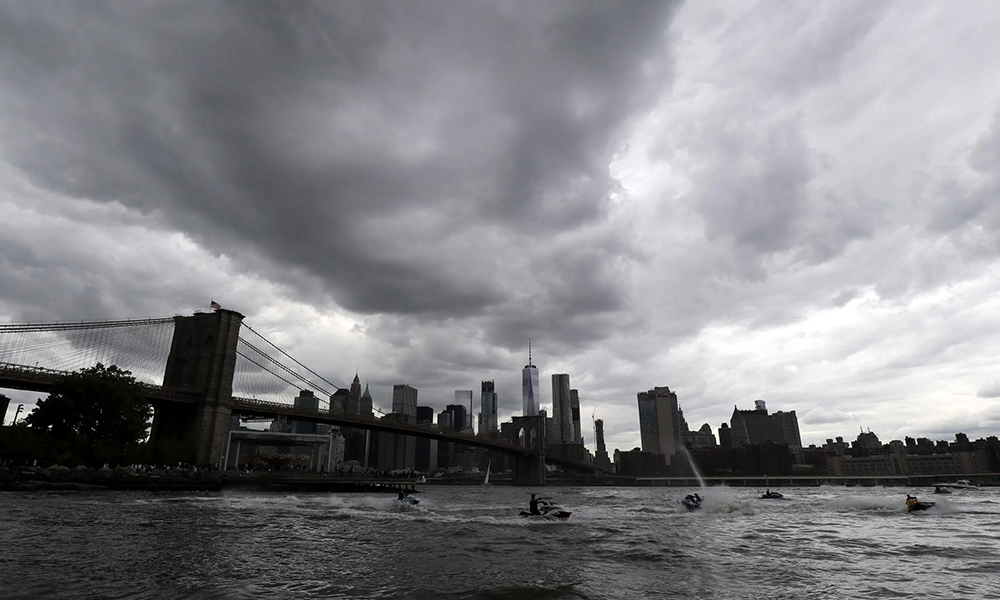
关于写字楼以及疫情引发的世界末日的讨论可能已经平息,但这一行业的问题并没有消失。如果说有什么变化的话,那就是在疫情爆发四年后,写字楼的空置率还在增加。
穆迪公司(Moody’s)近日发布的一份分析报告显示,今年第二季度,“写字楼空置率达到了创纪录的20.1%,历史上首次突破20%大关。由于工作行为的转变比四年前爆发的第一波疫情更持久,写字楼行业出现的缓慢流失导致了空置率的稳步上升。”
据穆迪公司称,正如《财富》杂志此前报道的那样,上一季度的写字楼空置率已经达到19.8%,比1986年和1991年的衰退峰值高出50个基点。
前一篇分析报告的合著者、助理经济学家尼克·卢埃特克(Nick Luettke)当时对《财富》杂志表示:“这两个历史性峰值是宏观经济状况导致的。1986年的空置率上升是由供应激增和大规模建设造成的,而1991年的空置率上升是由前十年的建设与当时更大的经济不确定性相结合造成的。”
工作习惯的“持久转变”
正如我们所知,这一次的需求骤降是由于远程工作,但利率也是一大影响因素(美联储多次加息以抑制飙升的通胀,其在2022年达到了40年来的最高水平)。所有商业地产对利率都很敏感,在经历了十年的低息借款之后,利率上升尤其令人痛苦。尽管利率最终会回落,但需求下降的问题似乎仍将普遍存在。
穆迪公司表示:“与之前的峰值相比,当前写字楼市场动荡的根本原因有所不同。与其说是宏观经济的不确定性,不如说是在疫情拐点出现四年后,我们接近工作模式的平衡,该行业正在发生持久的转变。”
更不必提及,Perot Group和Hillwood董事长小罗斯·佩罗(Ross Perot Jr.)曾对《财富》杂志表示,“我们还需要很多年才能真正了解疫情对世界造成的破坏。”他说,首先,“它打破了数百万人过去每天在实体办公室上班的习惯模式。”
需求不足导致租金下降。今年第二季度,实际租金下降了0.1%,去年同期下降了0.5%。根据分析,2021年和2022年的租金增长为正,但这一情况发生了变化,租金已经连续四个季度出现负增长或持平。与此同时,第二季度的净吸纳量(本质上是指租赁的总面积减去一定时期内空置的面积)为-1360万平方英尺(约合-126万平方米),是近三年来的最差水平。
分析指出:“写字楼行业空置率的上升凸显了该行业目前的困境,人们自然担心空置率会继续攀升到多高。目前,仅从表面上看,经济状况表现良好,这可能对写字楼有利。不过,未来空置率的走向和速度将取决于美联储如何驾驭软着陆。”
到目前为止,在通胀报告高于预期之后,美联储今年似乎仍将降息一次。目前尚不清楚一次降息能在多大程度上帮助写字楼行业,但该行业面临着一个更大的问题,那就是需求收缩——从这个角度来看,写字楼行业的表现并不理想。而凯投宏观(Capital Economics)则预测,到明年年底,写字楼价值将从峰值跌至谷底,跌幅将超过40%,甚至到2040年都不会回升(与该公司之前的预测相比,这一修正更令人担忧)。不过,穆迪公司商业地产分析主管凯文·费根(Kevin Fagan)曾对《财富》杂志表示,他预计空置率将在明年之后开始下降。(财富中文网)
译者:中慧言-王芳
关于写字楼以及疫情引发的世界末日的讨论可能已经平息,但这一行业的问题并没有消失。如果说有什么变化的话,那就是在疫情爆发四年后,写字楼的空置率还在增加。
穆迪公司(Moody’s)近日发布的一份分析报告显示,今年第二季度,“写字楼空置率达到了创纪录的20.1%,历史上首次突破20%大关。由于工作行为的转变比四年前爆发的第一波疫情更持久,写字楼行业出现的缓慢流失导致了空置率的稳步上升。”
据穆迪公司称,正如《财富》杂志此前报道的那样,上一季度的写字楼空置率已经达到19.8%,比1986年和1991年的衰退峰值高出50个基点。
前一篇分析报告的合著者、助理经济学家尼克·卢埃特克(Nick Luettke)当时对《财富》杂志表示:“这两个历史性峰值是宏观经济状况导致的。1986年的空置率上升是由供应激增和大规模建设造成的,而1991年的空置率上升是由前十年的建设与当时更大的经济不确定性相结合造成的。”
工作习惯的“持久转变”
正如我们所知,这一次的需求骤降是由于远程工作,但利率也是一大影响因素(美联储多次加息以抑制飙升的通胀,其在2022年达到了40年来的最高水平)。所有商业地产对利率都很敏感,在经历了十年的低息借款之后,利率上升尤其令人痛苦。尽管利率最终会回落,但需求下降的问题似乎仍将普遍存在。
穆迪公司表示:“与之前的峰值相比,当前写字楼市场动荡的根本原因有所不同。与其说是宏观经济的不确定性,不如说是在疫情拐点出现四年后,我们接近工作模式的平衡,该行业正在发生持久的转变。”
更不必提及,Perot Group和Hillwood董事长小罗斯·佩罗(Ross Perot Jr.)曾对《财富》杂志表示,“我们还需要很多年才能真正了解疫情对世界造成的破坏。”他说,首先,“它打破了数百万人过去每天在实体办公室上班的习惯模式。”
需求不足导致租金下降。今年第二季度,实际租金下降了0.1%,去年同期下降了0.5%。根据分析,2021年和2022年的租金增长为正,但这一情况发生了变化,租金已经连续四个季度出现负增长或持平。与此同时,第二季度的净吸纳量(本质上是指租赁的总面积减去一定时期内空置的面积)为-1360万平方英尺(约合-126万平方米),是近三年来的最差水平。
分析指出:“写字楼行业空置率的上升凸显了该行业目前的困境,人们自然担心空置率会继续攀升到多高。目前,仅从表面上看,经济状况表现良好,这可能对写字楼有利。不过,未来空置率的走向和速度将取决于美联储如何驾驭软着陆。”
到目前为止,在通胀报告高于预期之后,美联储今年似乎仍将降息一次。目前尚不清楚一次降息能在多大程度上帮助写字楼行业,但该行业面临着一个更大的问题,那就是需求收缩——从这个角度来看,写字楼行业的表现并不理想。而凯投宏观(Capital Economics)则预测,到明年年底,写字楼价值将从峰值跌至谷底,跌幅将超过40%,甚至到2040年都不会回升(与该公司之前的预测相比,这一修正更令人担忧)。不过,穆迪公司商业地产分析主管凯文·费根(Kevin Fagan)曾对《财富》杂志表示,他预计空置率将在明年之后开始下降。(财富中文网)
译者:中慧言-王芳
Talk of the office and its pandemic-powered apocalypse might have died down, but the sector’s troubles haven’t. If anything, four years after the pandemic’s onset, office vacancies are growing.
In the second quarter of this year, “the office sector set a record vacancy rate at 20.1%, breaking the 20% barrier for the first time in history,” a Moody’s analysis published today read. “The slow bleed occurring in the office sector has led to a steady rise in the vacancy rate as permanent shifts in working behavior have outlasted the initial wave of the pandemic four years ago.”
In the prior quarter, as Fortune previously reported, the office vacancy rate had already reached 19.8%, which was 50 basis points above recessionary peaks recorded in 1986 and 1991, according to Moody’s.
“The two historic peaks came as a result of underlying macroeconomic conditions,” Nick Luettke, coauthor of the previous analysis and associate economist, told Fortune at the time. “The 1986 vacancy rise came as the result of surging supply with high construction levels, while 1991 came as a result of the previous decade of construction fusing with greater economic uncertainty at the time.”
‘A lasting shift’ in work habits
This time around, as we know, demand plummeted thanks to remote work, but interest rates were an issue too—the Federal Reserve raised rates multiple times to tame surging inflation that reached a four-decade high in 2022. All commercial real estate is sensitive to interest rates, and after a decade of cheap money, higher rates were especially painful. Still, while interest rates will eventually come down, the issue of demeaning demand, it seems, will remain prevalent.
“The current turbulence in the office sector has a different root cause than previous peaks,” Moody’s said today. “Rather than macroeconomic uncertainty, a lasting shift is occurring in the sector as we near equilibrium of working models four years after inflection point of the pandemic.”
Not to mention, Ross Perot Jr., chairman of the Perot Group and Hillwood, once told Fortune that “it’ll be years before we really understand the damage the pandemic did to the world.” For one, he said, “it broke the habit patterns of millions of people that used to go to work every day in a real office.”
That lack of demand translates to falling rents. In the second quarter of the year, effective rents fell 0.1%, and 0.5% in the last year. Rent growth was positive in 2021 and 2022, but that changed, and rents have been negative or flat for four consecutive quarters, according to the analysis. Meanwhile, net absorption (which essentially refers to the total amount of space that’s been leased, minus the amount of space that’s been vacated for a certain period) was at -13.6 million square feet in the second quarter, the worst it’s been in almost three years.
“The office sector’s rising vacancy rate highlights the sector’s current struggles, and there’s natural concern over how high the rate will continue to climb,” the analysis read. At this moment, the economy is doing fine on paper, which could be beneficial for offices. Still, “the future direction and speed of the vacancy rate will hinge on the Federal Reserve’s navigation of the soft landing.”
So far, the Fed seems set to cut interest rates a single time this year following hotter-than-expected inflation reports. It’s not clear how much one rate cut would help the office sector, but it faces a much bigger problem of fading necessity—and on that measure, the office world hasn’t fared too well. For its part, Capital Economics predicted office values will fall more than 40% from peak to trough by the end of next year, with no recovery even by 2040 (a more haunting revision from the firm’s prior call). Still, Moody’s head of commercial real estate analysis, Kevin Fagan, once told Fortune he expected vacancies to begin to fall after next year.






